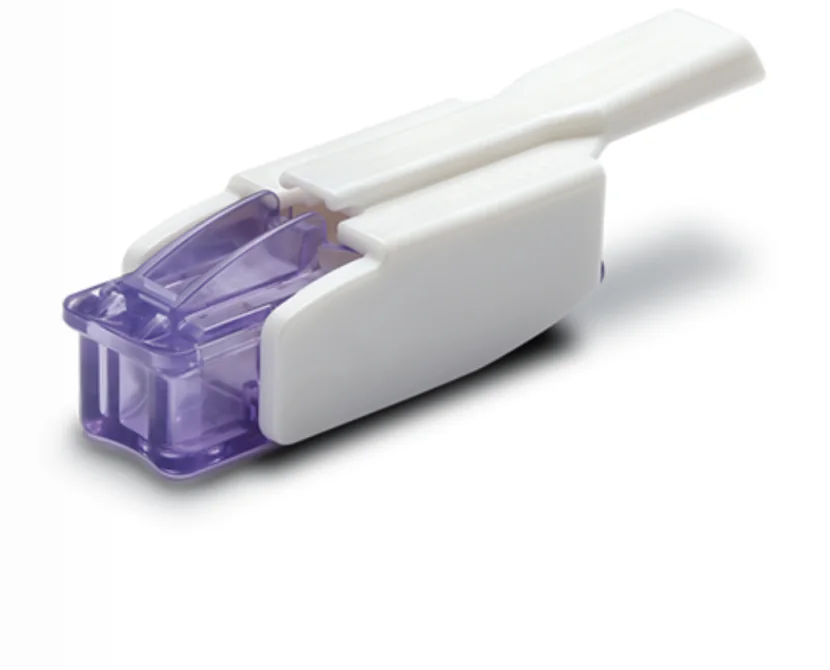Introducing Inhaled Insulin

Everyone with type 1 diabetes needs insulin to live. Despite the advancements in medications to treat type 2 diabetes, many need insulin to reach their glucose targets. This is due to the natural progression of the condition, especially as many people are being diagnosed at a younger age and living longer with the condition. Less than half of people with diabetes meet the A1C target of <7%, and it’s estimated that only 21% of people with type 1 have an A1C <7%. Although insulin is extremely effective, hypoglycemia (or low blood glucose) often limits the ability to go up on insulin doses1.
Limitations of Injectable Insulin
Most people take their insulin as an injection in their skin via an insulin pen, insulin syringe, or insulin pump. Limitations include:
- Scar Tissue: This can build up after repeated injections in the same place. It may contribute to inconsistent insulin absorption and dosing.
- Injection burden: Additional insulin for food or to correct above-range blood glucose requires more injections.
- Missed doses: Up to 20% of mealtime injections are intentionally missed because it can be hard to time them correctly or inconvenient to pull out a pen or syringe2.
Inhaled Insulin
Many people are surprised to learn that there is an alternate way to take insulin by inhaling it. Inhaled insulin was first introduced in 2006 as Exubera. This was a promising approach to insulin delivery because inhaled insulin works faster and is more physiological, meaning it acts more like insulin in a person without diabetes with a functioning pancreas. Unfortunately, the dosing was confusing (dosed in milligrams instead of traditional insulin units), and the device used to inhale it was very large3. It was ultimately removed from the market in 2007 due to a lack of interest.
This wasn’t the last we would see of this new route of insulin delivery. Innovation regarding inhaled insulin continued, and Afrezza was introduced in 2014. Afrezza is a dry powder formulation of human insulin absorbed into Technosphere microparticles. The particles are absorbed into the lungs and then dissolved into the bloodstream4. This was a huge improvement from Exubera in that it is taken with a small disposable inhaler, which easily fits in the palm of the hand. The dosing is also simplified and comes in cartridges labeled with insulin units.
It is considered an ultra-rapid-acting insulin. Inhaled insulin is designed to replace subcutaneous rapid-acting insulin. Once breathed in, insulin is in the bloodstream in less than 1 minute. It starts working to lower blood glucose in 12 minutes and lasts in the system for 1.5 to 3 hours, depending on the dose. Larger doses typically last longer5. Studies show that it lowers A1C comparable to subcutaneous rapid-acting insulins with reduced rates of late postprandial hypoglycemia in people with type 1 diabetes. This means less low blood glucose levels 2 to 5 hours after the meal6. See Table 1 for Insulin action times comparing those without diabetes to pulmonary delivery (inhaled) and subcutaneous injections.
Table 1 Comparison of Insulin Delivery7
| Insulin action times | Circulating insulin in those without diabetes | Pulmonary delivery (Inhaled) | Subcutaneous Delivery (Injections) |
| Time to measurable effect | 10 units | 12 minutes | 17-30 minutes |
| Time to peak effect | 45 minutes | 45 minutes | 90-120 minutes |
| Time for effect to return to baseline | 210 minutes | 180 minutes | 275-320 minutes |
Advantages of Inhaled Insulin
- Works Quickly: It works more quickly than any other mealtime insulin. Therefore, you may not need to pre-bolus 10 to 15 minutes before eating, as recommended with most subcutaneous insulins. It may be taken right at the start of the meal. There are times when you may not know when you are eating, such as out at a restaurant waiting for food or having a busy day and waiting for a break. Other times, you may just not remember to pre-bolus. This offers more flexibility. Additionally, if blood glucose is running above range, inhaled insulin can bring blood glucose down more quickly since it works faster.
- Out of the System Quickly: It leaves the body quickly. This may allow you to take more units to correct above-range blood glucose without worrying about stacking insulin. It can be frustrating when blood glucose is elevated, and it can be tempting to give more and more insulin to bring it down. The problem with most rapid-acting insulins is that they take 1 to 3 hours to peak and last for over 5 hours in the system. This can lead to low blood glucose if you continue to give more insulin.
- Replaces Injections: If you don’t like injections, inhaled insulin can be a great alternative. It also reduces the need to carry extra sharps like syringes or pen needles.
Afrezza: Who is it For?
Afrezza is indicated for adults with type 1 or type 2 diabetes. For type 1, it should always be used in combination with a background insulin, which is most commonly a long-acting insulin such as insulin glargine or degludec. It’s also possible to use in combination with an insulin pump.
Afrezza: Who is it NOT For?
It is not recommended for use in people who smoke or recently stopped smoking within the last six months. It should not be used in people with chronic lung disease such as asthma or chronic obstructive pulmonary disease (COPD). It should also not be used during episodes of low blood glucose. It’s not meant to treat diabetic ketoacidosis (DKA).
How to Dose?
Dosing Afrezza is much more of an art than a science. You can say goodbye to strict carbohydrate counting. Afrezza comes in 4-unit, 8-unit, and 12-unit cartridges. This may sound surprising, especially if you take small doses of insulin. It’s important to note that 4 units of inhaled insulin act much more like 2 units of injectable insulin. If a dose needs to be higher, it’s easy to inhale multiple cartridges. The cartridges come in multiple options; you can combine the different doses to mix and match. If a food required 10 units of insulin aspart, it likely would require 20 units of Afrezza, which could be taken using one 8-unit and one 12-unit cartridge.
Even though Afrezza often requires 1.5 to 2 times as much insulin as injectable insulin, the recommendation is to start dosing more conservatively. Table 2 describes the package insert recommendations.
Table 2 Afrezza Dose Conversion
| Injected Mealtime Insulin Dose | Afrezza Starting Dose | Anticipated Dose After Titration |
| Up to 4 units | 4 units | 4-8 units |
| 5-8 units | 8 Units | 8-12 units |
| 9-12 units | 12 units | 12-20 units |
| 13-16 units | 16 units | 16-24 units |
| 17-20 units | 20 units | 20-32 units |
| 21-24 units | 24 units | 24-36 units |
Correcting Above-Target Glucose
Afrezza should be taken at the start of the meal, but additional correction doses can be taken as early as 1 hour after starting the meal if blood glucose is elevated. In one of the clinical trials, the recommendation was not to give any additional insulin if blood glucose was under 150mg/dL. If between 151 and 200mg/dL, then 4 units were recommended at 1 hour. If over 201, 8 units were recommended 1 hour after eating, and 4 units were recommended after 2 hours. This is easiest done while wearing a continuous glucose monitor (CGM).
How to Take Afrezza8
- Select the cartridge for the right dose.
- Blue: 4 units
- Green: 6 units
- Yellow: 12 units
- Hold inhaler level in one hand with white mouthpiece on top and purple base on bottom.
- Open inhaler by lifting white mouthpiece to a vertical position.
- Place cartridge flat with the pointed end of cartridge lined up with the pointed end of the inhaler and then close.
- Keep inhaler level to avoid loss of powder.
- Remove mouthpiece cover.
- Exhale with inhaler away from mouth.
- Position inhaler in mouth and tile inhaler down towards your chin. Close lips around the mouthpiece.
- Inhale deeply through the inhaler.
- Hold your breath for as long as comfortable and then exhale and breathe normally.
- Replace mouthpiece cover, open inhaler, remove cartridge and discard.
Side Effects
Hypoglycemia or low blood glucose can occur with any insulin, including Afrezza. Additionally, the most common side effects include cough and throat pain or irritation. Cough is usually a dry cough that occurs within 10 minutes of inhalation and generally gets better after continued use. Some tips to help with cough are to keep Afrezza at room temperate and have a sip of water before inhaling9.
In summary, Afrezza is an inhaled insulin that offers an alternative to traditional subcutaneous insulin delivery. It can be used at mealtimes or to correct above-range blood glucose in people with type 1 or type 2 who need mealtime insulin. If you take insulin and are not achieving your management goals, it’s good to be aware of all your options and talk to your healthcare team to determine if Afrezza could be a good option for you.
Interested in learning more about inhaled insulin?
Join us for two exciting upcoming events! Sign up for a webinar with Diana Isaacs, PharmD, BCPS, BC-ADM, CDCES: Discover the benefits and practical tips for using inhaled insulin.

And join us for a workshop with Ginger Vieira, diabetes expert and advocate: Dive deeper into how inhaled insulin can fit into your diabetes management plan. Attend either at 12:00 PM ET or 7:00 PM ET.


References:
- Foster NC, Beck RW, Miller KM, et al. Diabetes Technol Ther. 2019;21(2):66-72.2
- Heinemann L, Parkin CG. J Diabetes Res. 2018:4568903. doi: 10.1155/2018/4568903. Peyrot M, Rubin RR, Kruger DF, Travis LB. Diabetes Care. 2010;33(2):240-245
- Jacob Oleck, Shahista Kassam, Jennifer D. Goldman; Commentary: Why Was Inhaled Insulin a Failure in the Market?. Diabetes Spectr 1 August 2016; 29 (3): 180–184. https://doi.org/10.2337/diaspect.29.3.180
- Wilson LM, Castle JR. Recent Advances in Insulin Therapy. Diabetes Technol Ther. 2020 Dec;22(12):929-936. doi: 10.1089/dia.2020.0065. Epub 2020 May 12. PMID: 32310681; PMCID: PMC7864088
- FAQs – AfrezzaAssist – Your Questions Answered https://afrezza.com/faqs
- Bode BW, McGill JB, Lorber DL, Gross JL, Chang PC, Bregman DB. Diabetes Care. 2015;38(12):2266-2273
- . 5. Caumo A, Bergman RN, Cobelli C. Insulin sensitivity from meal tolerance tests in normal subjects: a minimal model index. J Clin Endocrinol Metab. 2000;85(11):4396-4402. 6. Grant M, Heise T, Baughman R. Clin Pharmacokinet. 2022;61(3):413-422. 7. Fiasp (insulin aspart injection) Prescribing Information. Novo Nordisk. 8. Lyumjev (insulin lispro-aabc injection) Prescribing Information. Eli Lilly and Company
- Afrezza.com Instructions-for-Use-Feb-2023 https://afrezza.com/wp-content/uploads/2023/03/Instructions-for-Use-Feb-2023.pdf
- McGill JB, Peters A, Buse JB, et al. Clin Drug Investig. 2020;40(10):973-983
Image from Mannkind.
Written by






